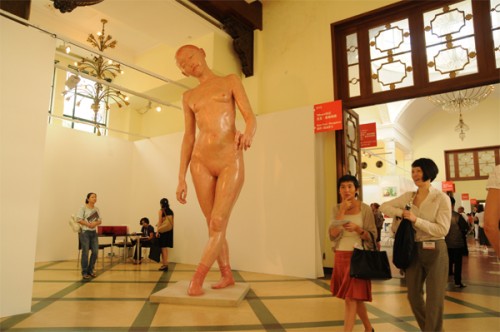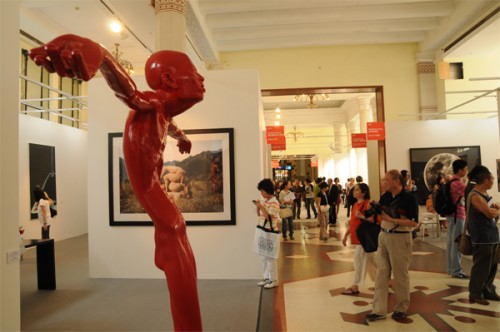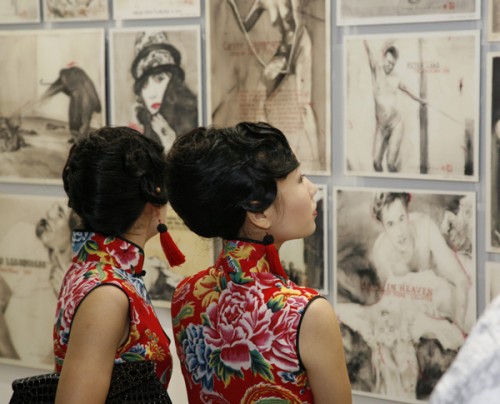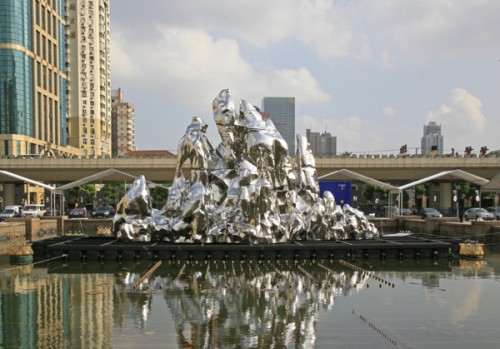The future in China is in the hands of new generation of Chinese collectors.
 Installation view of the Best of Galleries section, ShContemporary 2008
Installation view of the Best of Galleries section, ShContemporary 2008Courtesy ShContemporary
How has the unprecedented economic crisis affected the art market in Asia? Which fairs will survive the very competitive art fair scene among Asian cities? We spoke to the new fair director of ShContemporary, planning to initiate a collector development program in China, about the current state of the market and the future of art fairs.
Interview: ART iT
– Some say the Asian art market has started to recover recently from the Lehman Brothers shock that hit last September.
The auction market has recovered more quickly, in part due to those people who are buying for investment. Art Basel did well, which is a promising indicator for art fairs, but the gallery market in general is recovering more slowly. What we have learned from fairs is that America has been hit the worst, we all know this, then Europe, and then Asia. Japan was hit less hard than Korea. And after being hit so hard, Korea is now recovering more quickly than perhaps anywhere else. China has been affected less than other Asian countries, or maybe all other countries or major economies in the world. That’s why we’re concentrating on ways to develop Chinese collectors. The future in Asia is in the hands of the new generation of Chinese collectors, because they will have more spending power than anybody else. This is why we’ve launched a new initiative: the Collector Development Program.
 ShContemporary 2008 Courtesy ShContemporary
ShContemporary 2008 Courtesy ShContemporary
– Is it true that Chinese collectors only buy the works of Chinese artists?
That is not true. There are more and more people who want to buy Warhol, Hirst and other contemporary brand names. But the whole artistic infrastructure needs to be developed. That means we need more museums shows on international art, and Chinese galleries to represent more international artists. More serious art magazines like Contemporary Art & Investment have in-depth coverage of international artists and criticism, but many magazines concentrate on investment, and mostly on Chinese artists, since that’s what they know best.
Of course Chinese collectors, like any collectors, will give preference to local artists first. But if you stay too local, you become insular. The more international work there is available through the market, the more open the market becomes. So, it’s our aim to open up the market as much as possible. That’s part of the thinking behind the CDP.
‘Developing’ Chinese collectors
 ShContemporary 2008 Courtesy ShContemporary
ShContemporary 2008 Courtesy ShContemporary
– What exactly will you do in your Collector Development Program’?
There are three key words: educate, inspire, and network.
Educate: We’ll have a partnership with CAFA (Central Academy of Fine Art). They have a profile as the most professional and best art school in China. That profile is important to bring to the table with private banks and other groups. We introduce new collectors to them and they get more students. It’s mutually beneficial. The educational process is extremely important, whether it’s just one event or a whole course, for new collectors to find their bearings, to learn how to make decisions, how to enjoy the process.
Inspire: We work with Chinese banks that have clients with at least a million dollars in their bank accounts. They advise their VIP clients on all kind of investments and most want to extend those services to investing in art. But they don’t know how to go about it. They have programs, part of which involves taking these clients abroad, but they don’t have the access. So this is where we come in. We take them on trips to different cities to see top collectors – to visit their homes, see how they’ve built their collections over decades, hear their stories about collecting art. Those who thought being a collector meant buying a million-dollar painting and hanging it on the wall, find out that being a collector can be so much more.
Third is of course to network. By becoming a collector you are not just collecting art and meeting artists; you are meeting other entrepreneurs, you are meeting the world. Because art collecting and other collectors are all over the whole world, from all professions. The byproduct of all these things is buying art.
– That’s acting as a form of art advisor, is it not?
We are not art advisors. We need to stay completely impartial, and not advise on what to buy. Instead we show people different methodologies so that they can choose for themselves. We don’t advise on who to buy from, or what to buy. We just want them to know how to buy, how to become a collector. And the more support we give them, the more likely it is that they will come to our fair. And the more collectors that come to our fair, the more the galleries… And that’s how we make our business: we sell booths to galleries. So it’s completely transparent. But of course, the wonderful thing is that – if this project is successful – the whole market benefits, not only us.
Hong Kong as a competitor
 Zhan Wang Floating Island of Immortals
Zhan Wang Floating Island of Immortals Long March Space (Outdoor projects section, ShContemporary 2008)
Courtesy ShContemporary
– Some people say Hong Kong has a big advantage as an art fair in Asia because of their very low tax system. How will you compete with them and try to survive?
Shanghai has good services, glamorous bars and restaurants, plus, the art scene. There’s a scene, there are things to see apart from the art fair. The environment is much more conducive to long-term development. I’m not talking about whether Hong Kong is good or bad. I’m just saying that when you look at the facts, Hong Kong has a short-term advantage, while Shanghai has long-term advantages.
We’re offering free hotel accommodations to all foreign collectors this year. All! After two years running, we have quite a big database of collectors outside Mainland China – in the thousands. If all of them come, okay, we’ll be in big financial trouble, but we’ll have a fantastic art fair, and everybody will want to come again. So that’s why this year we’re confident it’s going to be a good fair. We’re just nervous about sales. This is something we can’t guarantee. We can invite the collectors, but like the old English saying, ‘you can lead a horse to water, but you can’t make it drink.’ (Laughs)

Colin Chinnery
Artist and curator. Born 1971 in Edinburg, raised in Beijing. Chief curator and deputy director of the Ullens Centre for Contemporary Art from 2006 to 2008. New director of ShContemporary 2009.
ShContemporary 2009
9.10-13
Shanghai Exhibition Center
http://www.shcontemporary.info/
ART iT Snapshots: DISCOVERIES: Discovering Contemporary
ART iT Interview: Kataoka Mami, Curator, ShContemporary DISCOVERIES
